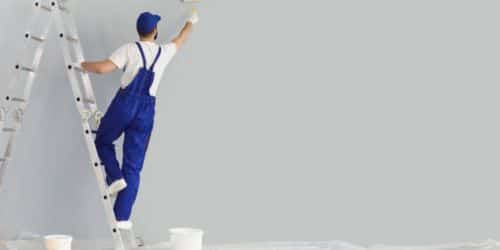A painter, often known as a Professional Painter, is someone who paints buildings for a living. Their responsibilities include coordinating the efforts of a crew of Painters, communicating with clients about color schemes and pricing, and maintaining an inventory of necessary equipment including brushes, rollers, tarps, and ladders. Read further to know more about where a painter work and how much they make. We also added some things painters need to do before painting in order to make their works beautiful. Let’s dive in!
Who Is a Painter?
A painter is an artist who uses paint and brushes to create two- or three-dimensional works of art on a wall or canvas. Artists use a wide variety of approaches, styles, and materials to convey their thoughts, feelings, and observations via painting. They might use oil paints, acrylics, watercolors, or something else entirely, all of which have their own quirks and possibilities.
It is common practice for painters to have an idea or inspiration in mind before applying their skills to the chosen surface. They make choices on color, composition, brushwork, and texture to produce a work of art that is both aesthetically pleasing and conceptually significant. Landscape painters, still life painters, portrait painters, abstract painters, and contemporary painters are just a few examples. Their contributions to our shared cultural history and the public forum for introspection they provide are reflected in the widespread distribution of their works among museums, galleries, private collections, and public settings. Artists who paint for a living can choose to sell their creations or accept commissions from private clients, businesses, and public institutions.
Types of Painters
Many different kinds of painters exist, each with their own distinct set of skills and interests. Common categories of artists that paint:
#1. Portrait Painter
Artists that specialize in portraiture strive to capture their subjects’ likeness and character in paintings that are either realistic or abstract in style. Clients frequently request to create portraits for family, business, or historical significance.
#2. Landscape Painter
Artists who paint landscapes have made it their life’s work to capture the wonder and spirit of the outdoors. Artists use a wide range of mediums to portray landscapes that capture the spirit of a place, from mountains and forests to rivers and skies.
#3. Still Life Painter
Objects like flowers, fruits, ordinary goods, and symbolic artifacts are the focus of still-life paintings. To investigate topics like symbolism, aesthetics, or the fleeting aspect of life, they meticulously organize and display these artifacts.
#4. Abstract Painter
Artists in the abstract genre don’t try to portray real-world scenes or things in their paintings. They emphasize the importance of the viewer’s own perception as they seek to convey feelings, thoughts, or concepts through the use of color, shape, line, and texture.
#5. Impressionist Painter
The loose brushwork and bold colors characteristic of Impressionist art became popular in the late 19th century in an attempt to represent the transient effects of light and environment. They frequently paint in the open air (en plein air), capturing the overall atmosphere rather than the minute details of a picture.
#6. Expressionist Painter
Expressionist painters place a strong emphasis on expressing their emotions, feelings, or subjective experiences via their work. To elicit an emotional response or communicate a certain message, they employ oversized and exaggerated shapes, hues, and brushwork.
#7. Contemporary Painter
There is a broad spectrum of styles and methods employed by today’s painters, who frequently test the limits of the medium. The dynamic and ever-changing nature of contemporary art is reflected in their willingness to explore new approaches, materials, and themes.
What Does a Painter Do
It’s crucial to your company’s reputation and future success to hire skilled Painters. The following are the things a painter does:
- Consultation with customers to establish painting needs and guidance through decision-making processes
- Putting up temporary scaffolding as needed
- Preventing paint from getting on baseboards, floors, furniture, and other surfaces by covering them with drop cloths, masking tape, and other protective coverings.
- Installing exhaust fans and other breathing apparatus to shield painters from toxic gases
- Cleaning, patching, and sanding surfaces to be painted in order to get them ready for paint is called surface preparation.
- Priming and sealing surfaces prior to painting increase paint adhesion.
- Creating custom color combinations for finishing work
- Applying a coating of paint, stain, or varnish to a surface with a paintbrush, roller, or sprayer.
- Keeping a stock of paint tools including rollers, brushes, and tarps
- Taking off the old coating with scrapers, chemicals, or heat
- Cost and time estimates for painting jobs
- Using water, solvents, and other cleaning aids to disinfect machinery, tools, and workspaces.
- Examining and carrying out tasks and orders
- Fixture relocation (such as door handles or light switch plates)
- Observing precautions, guidelines, and laws
Painter Skills and Qualifications
This section needs to be brief yet informative so that applicants may quickly determine if they are qualified for the painting position. Painters typically have the following abilities and experiences:
- Possessing a refined sense of color and beauty
- a focus on detail
- Capabilities of stamina, agility, and strength of body
- Knowledge of paints, brushes, and other supplies
- Ability to manage time effectively and finish projects on schedule
- Ability to interact with customers
- If they have a crew job, they can collaborate and work together.
Painter Requirements
Depending on the field and scope of the employment you seek, you may need to have particular qualifications in order to land a job as a painter, such as:
#1. Education
Painters need to have completed either high school or earned a GED before entering the field. Depending on the nature of the work and the company’s expectations, a certain amount of relevant work experience may be required for some positions. Color theory and the different kinds of finishes are two areas of expertise that are preferred but not required, as employers often provide training in these areas.
#2. Training
Apprenticeship programs and on-the-job training provide many painters with the industry- and role-specific expertise they need to succeed. Training in the workplace might run anything from a few weeks to a few months. This orientation often occurs within the first 30–90 days on the job. During training, you may be required to observe experienced painters at work and practice similar tasks under close supervision before you are allowed to work independently.
#3. Certifications
You can show your present and future employers that you are competent and qualified by earning a certification. Painters are required to obtain a license or certification in some jurisdictions. Certifications are a great way for painters to learn more about their field and develop in their careers. Some of the most common painter certificates are:
- State licenses or certifications: It is necessary for painters in several states to have some sort of official certification or license. Painters often need several years of experience and certification in states that demand it.
- Verification of Lead Safety: Painters are required by the Environmental Protection Agency (EPA) to undergo training in Renovation, Repair, and Painting (RRP).
- Professional certifications: The Society for Protective Coatings and the National Association of Coatings Experts both offer professional certificates for painters.
Where Does a Painter Work
A painter’s workspace may change depending on their specialty and personal preferences. The following are places where a painter work:
#1. Studio
Many artists have their own studios where they can work uninterrupted. Studios like these can be found in a variety of settings, including private residences, coworking spaces, and artist communities. Studio spaces allow artists to work undisturbed, keep their supplies in order, and have plenty of room to spread out and develop their ideas. The best circumstances for painting are achieved in studios equipped with easels, work tables, supply storage, and appropriate lighting.
#2. Ambient Settings
Particularly landscape and plein air painters favor the great outdoors as a studio. They take their art supplies and easels out into the wild, setting up shop in places like parks and gardens. Artists can get a more immediate and accurate depiction of outdoor scenes by painting en plein air, where they can examine and record the scene’s colors, lighting, and ambiance as they see it.
#3. Art Exhibits and Galleries
Galleries, museums, and art exhibitions are common venues for painters to show off their final works. Exposure to more people, including potential collectors and admirers of their work, is gained through these events. Galleries often host both solo and group shows, and artists are often invited to participate in the installation of their works.
#4. Art Institutions and Studios
It’s not uncommon for artists to teach at or serve as artists-in-residence at cultural establishments like museums and universities. Painting studios, printing workshops, and other such facilities may be available to them, allowing them to teach, engage with students, and create.
#5. On-site Commissioned Work
On-site Painting jobs that need the artist to be physically present can be considered commissioned work. Mural painting for public areas, interior painting for homes and businesses, and preservation and restoration of cultural landmarks are all examples. In such a scenario, the location of the project would be the place of employment for the painter.
#6. Digital and Web-Based Environments
Some artists now also operate in digital or online environments as a result of the widespread adoption of digital tools. They might utilize digital painting programs to produce their works and then exhibit and sell them online. Artists can reach people all over the world through virtual spaces like art markets, social networking sites, and online exhibitions.
What Do Painters Do Before Painting?
Have you been thinking of what do painters do before painting? Here are some of them; Get a power washing or other cleaning service done before the painters show up to paint your house. Contractors who don’t wash the area they’re painting before applying new paint will find that the new coat quickly bubbles and peels off the siding.
Also, clean up or remove any flaking paint before painting. Even after a new coat of paint has been applied to a surface, the old paint will continue to peel. If your contractor doesn’t scrape and sand the peeling paint, your new coat of paint will peel off just as soon as the old one did.
Paint should be used on a dry surface. Never let your painter paint on a wet wall. Your contractor should never paint on a surface that has been wet within the last few hours. If a contractor paints over a wet surface, the ensuing freeze-and-thaw cycle will eventually peel off the fresh coat of paint.
How Much Do Painters Make?
Painters might work for companies on a full-time, part-time, or seasonal basis. Pay for painters varies by factors such as education, years of experience, employer sector, company size, and geography. Overtime pay is another possible source of income for painters. Hourly wage average in the United States: $15.84. Also, salaries can start at $7.25/hr and go as high as $34.40/hr.
Is It Hard To Be a Painter?
It’s not really a hard job. However, being able to climb ladders, carry heavy equipment and tools, work in awkward positions, and stand for long periods are all necessary physical abilities for a painter.
What Do Beginner Painters Need?
The following are things a beginner needs:
- An easel to hold your artwork.
- Canvas (for acrylic or oil painters) or paper (for watercolor painters).
- A palette for color mixing.
- Brushes (suitable for your chosen medium).
- Palette knives.
- Paints.
- Solvent (if oil painting).
- Paper towels (for wiping your brush between strokes).
What Is the Difference Between a Painter and a Muralist?
Although they share a common skill set, Painters and Muralists can vary greatly in their actual artistic prowess. Painters, in contrast to Muralists, usually stick to painting in solid colors on walls and touching up imperfections. Muralists, in contrast, are very talented artists who can create stunning works of art on walls or enormous canvases, be they landscapes, cityscapes, or abstracts.
Final Thoughts
Painters often work for remodeling firms, general contractors, or repair and maintenance enterprises. They look at swatches of paint and figure out how to mix colors to get the right hue. Before they begin painting, it is their responsibility to protect the furniture, floors, and crown molding in the room. Scaffold set-up, drywall patching, and paint touch-up could also fall under their purview. Why not go for it if you love painting?
Related Articles
- INTERIOR PAINTER: Best Interior Painter Services, Types & Costs
- PAINTERS INSURANCE: What It Is, Coverage, Cost, and Top Providers
- The Best Top 10 PHOTO SELLING WEBSITE in 2023 (Updated)
- The Top Best 10 PAINT BRANDS FOR 2023, Updated!!!
- BEST BUY LOGO: Why is the Best Buy Logo Yellow? The Success Story!






